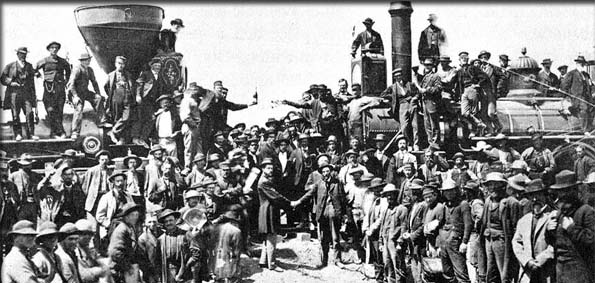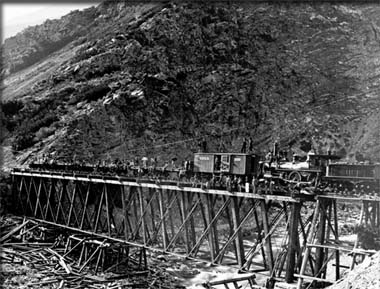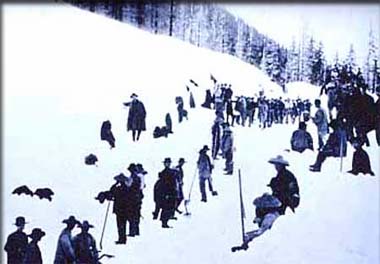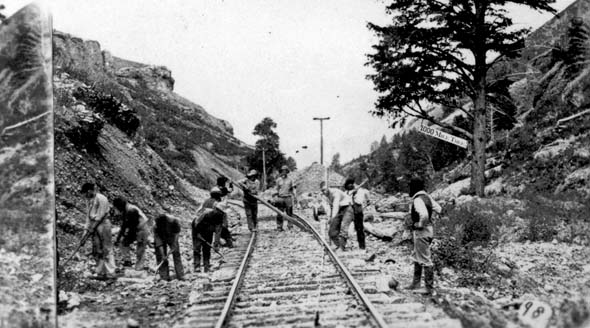 |
Building
the Trans-Continental Railroad |

As the middle of the 19th century loomed, there
was no good, efficient way to cross North America from coast-to-coast.
An overland trip using horses and wagons across the Great Plains
was long, arduous and dangerous. Going by ship meant a six-month
trip around South American's Cape Horn, risking storms and ship
wrecks. A combination of the two, a ship to the Isthmus of Panama
with a land crossing there of the jungle and another voyage
to San Francisco, was fraught with the possibility of contracting
malaria or yellow fever. What was needed was to build a railroad
across America, but that seemed an impossibility.
While building the 1,907 miles (3,069 km) of track
that would be needed was not a small job; the biggest obstacle
to such a project was the Sierra Nevada mountain range. This
formable set of mountains runs 400 miles north and south and
70 wide east and west along the eastern edge of California.
Before the state of Alaska was added to the union, it was the
highest and longest mountain range in the United States.
It wasn't the size or even the height of the mountains
that made it such a difficult problem for the railroad, but
the steepness. A railroad engine pulling cars can only climb
a grade of 2% under normal conditions (a rise of two feet for
every hundred foot of track). Because the Sierra Nevada was
so steep and its valleys so narrow, it seemed impossible that
one might build a gently-sloping track through them. Making
any attempt at doing this even more difficult was the weather
coming off of the Pacific Ocean that deposited extreme snow
in the range, sometimes as deep as 50 feet.
Theodore Judah
|
Seven
Quick Facts
|
| -Authorization:
Lincoln signed Pacific Railway Act into law on July 1st,
1861. |
| -Length:
1,907-miles (3,069 km) of track from Omaha to Sacramento. |
| -Start:
January 8, 1863, in Sacramento. |
| -Completion:
May 10, 1869, at Promontory Summit, Utah. |
| -Most
track laid in a single day: 10 miles by the Central Pacific
Railroad on April 28, 1869. |
| -Cost:
$150 to travel from coast to coast after the railroads
completion. |
| -Other:
Parts of the railroad, especially through the Sierra
Nevada Mountains, are still in daily use today.
|
Despite these challenger one man thought it could
be done. His name was Theodore Judah. Judah was a young, ambitious
engineer that by the 1860's had already built California's first
railroad. Judah dreamed of linking the coasts with a ribbon
of steel and took 23 trips into the mountains to scout a path.
In 1862 he traveled east to the nation's capital in Washington,
D.C. to convince the government that such a project could succeed.
Judah met with members of Congress and President
Lincoln. Lincoln, in particular, saw the need, especially during
the Civil War, of uniting the country with a rail line. So in
1862 he signed the Pacific Railroad Act. This law authorized
two companies, one working from the east and the other working
from the west, to build a railway across the western United
States. To encourage this endeavor, the government would grant
$16,000 for each mile of track laid over flat ground. The money
increased as the terrain got steeper, topping out at $48,000
in the most difficult mountains. In addition. the railroad companies
would be granted a 400 foot right-of-way along the tracks (later
the government would double this). This land grant was also
a huge financial enticement as the property along the tracks
would be very valuable once the rails were laid and the line
was in service.
Central Pacific Railroad
Judah worked with four shopkeepers from Sacramento,
California, to form the Central Pacific Railroad Company in
1863. The group had difficulty in raising the necessary funds,
however, and Judah had disagreements with the partners as he
perceived they were using legally-questionable schemes to obtain
the cash needed. Unfortunately, during a trip to the East Coast
to find new backers, Judah contracted yellow fever in Panama.
Ironically he died within a few days of a danger his proposed
railroad would have banished.
Without his chief engineer, the superintendent
of the Central Pacific, Charles Crocker, had to forge on by
himself. Perhaps the biggest problem he faced was labor. There
wasn't enough men in the Sacramento area to build the railroad
and those he did hire were soon enticed away by the promise
of silver and gold in the nearby mines of Nevada. In desperation,
Crocker decided to hire Chinese laborers. The Chinese were shockingly
discriminated against in California at the time and at first
his foremen and engineers were skeptical of the Asians' abilities
to do heavy construction work. As the project progressed, however,
it became obvious that these immigrants would take on the most
difficult and dangerous jobs with tireless efforts. Eventually,
they were employed in large numbers.
To push the rail line through the Sierra Nevada
Mountains, a large number of bridges and tunnels were required.
This meant blasting away many tons of rock. For this, gun power
was used. Using a method imported from their native country,
the Chinese would weave giant baskets and attach them to ropes.
The baskets would be lowered down from the top of a cliff filled
with workers aboard who would chisel holes in the rock and fill
them with gun power. After lighting the fuses, they would be
pulled up to the top of the cliff before the detonation.
|

Building
the Devils Gate Bridge over Weber Canyon in 1869.
|
Use of the basket was a dangerous arrangement
as high winds would blow it about and a small mistake could
set the gun power off prematurely. This procedure became even
more dangerous when the railroad tried to speed construction
by using the newly-invented explosive, nitroglycerine. Nitro
was more powerful than gun power, but was unstable and could
easily be set off by a small shock. The Central Pacific tried
to use nitro during two different periods, both ending in disaster
and the death of many Chinese labors. In the final accident,
construction foreman James Strobridge lost an eye, bringing
experiments with the dangerous blasting oil to an end.
With the winter came massive snows and the associated
avalanches brought construction to a standstill. To protect
the tracks and crew, it was necessary to build wooden snow sheds
over the right-of-way. These sheds, which ran along where the
track had been cut into a steep hill, had sloped roofs designed
to allow snow coming down the hillside to slide right over the
tracks without covering or damaging them, and then into the
valleys below. By the time construction was, over 37 miles of
these wooden snow sheds had been built.
Union Pacific Railroad
Back East, Dr. Thomas Durant had been named the
leader of the Union Pacific Railway which would forge a path
from the existing tracks in the Mid-West towards the Pacific
coast. The two railways would be in competition to lay as much
track as possible. Since the federal goverment granted money
and land for each mile laid, each company had the incentive
to do as much construction as they could.
In 1866, after several changes in chief engineers,
Civil War veteran General Grenville Dodge was put in charge.
He settled on a route starting from the city of Omaha and running
up the Platte Valley. While initially the Union Pacific would
have it much easier as they were laying track through much flatter
land, eventually they would need to cross the Rocky Mountains,
a significant obstacle, but not nearly as difficult as the Sierra
Nevada Range the Central Pacific would have to conquer.
To allow work to move quickly, General John S.
Casement, who was in charge of construction, built several railroad
cars equipped as portable bunkhouses and a galley for his men.
In addition, temporary, "hell-on-wheels" towns, made mostly
of canvas tents, also followed the moving construction site.
To provide meat, a herd of cattle was kept close by and hunters
were employed to augment this food supply with buffalo meat
from wild American bison found in the area.
|

A
Central Pacific Chinese railroad crew working in the snow.
|
Much of the difficulty General Dodge and his team
encountered was not with construction challenges, but with the
native American tribes they encountered. Decades of encroachment
on Indian lands by the Europeans had made the tribes distrustful
of the white man. The Native Americans saw his "iron horse"
and its tracks as a further violation of their territory. They
were also concerned with the massive hunting of the bison as
these animals provided much of the Indian's sustenance. All
these factors caused some of the Native American tribes to take
violent action to prevent the railroad's progress.
While the main construction group working on the
rails numbered about a thousand, making them difficult to attack,
smaller survey and preparation teams working ahead were easy
targets. In August of 1867, a band of Cheyenne, looking for
revenge on white soldiers that had stolen from them, knocked
down a telegraph line along the tracks. When a team of six repair
men were sent out to investigate, they were attacked and scalped.
Only one survived by playing dead. While he watched, the band
also attacked an approaching freight train, killing both the
engineer and fireman.
After a number of these incidents, General Dodge
appealed to the government for help. General Sherman, the former
Civil War hero who had burned Atlanta, promised to protect the
railway workers by waging war on the Native Americans.
Another problem was that the towns along the Union
Pacific's route often became dens of gambling and violence as
workers let off steam from their difficult and dangerous jobs.
It is from these thse towns many of the legends of the vilolent
American West were formed. Julesburg, Nebraska, soon acquired
the reputation as "the wickedest town in America" where, according
to journalist Henry Stanley, "not a day passes but a dead body
is found somewhere in the vicinity." Gamblers, desperados, gun
slingers and prostitutes all called the city their home.
General Dodge, angered by the activity in Julesburg
and the fact that it was occurring on Union Pacific land, ordered
the town to be cleared out and John Casement, in charge of railroad
construction, took 200 railroad men armed with rifles into it.
In the end, 30 of the squatters were killed and Casement declared
proudly, "They all died with their boots."
The Final Spike
Eventually, the Union Pacific rail line crossed
the Rockies and the Central Pacific completed its Sierra Nevada
tracks. The question soon became, where would the two railways
meet? Because each company was earning government money for
each mile of track laid, there was little incentive to find
a logical meeting point. Teams grading and preparing the land
for the track actually passed by within sight of each other
heading opposite directions. As a source of pride, the railways
also attempted to outdo each other on the amount of track they
could lay in a single day. The Central Pacific took the record
by laying 10 miles on April 28, 1869.
The U.S. President, General Grant, had to threaten
to withhold funds from both competitors before they finally
decided on an agreeable mutual meeting point at Promontory Summit,
north of the Great Salt Lake in Utah.
The combined railway was officially opened on
May 10, 1869. Two highly-decorated engines, one from each railway,
were pulled up within a few feet of each other with trains behind
them filled with celebrating workers. In between the trains
at the final connection, there was a ceremonial driving of the
"Last Spike," made of gold with a silver hammer. After the ceremony,
the spike was removed and is now in the Cantor Arts Center at
Stanford University.
News of the achievement was sent around the world.
A telegram arrived for President Grant declaring, "The Last
Rail is Laid! The Last Spike is Driven! The Pacific Railroad
is Completed!"
Once the railway went into service, travel time
from coast-to-coast dropped from six months to just a week (By
1876, an express service was offered that would take a person
from New York City to San Francisco in only 83 hours). The cost
also dropped from around $1,000 to just $150, so people and
goods could move across the country quickly and cheaply. The
rail line transformed the settlement of the American West by
bringing western states and territories firmly and profitably
into the "Union." Just as President Lincoln had thought, the
ribbon of steel had united the nation.
Construction
of the Union Pacific reaches a lone pine designated
as the "1,000 Mile Tree," a thousand miles
from the start at Omaha.

|

Copyright
2016 Lee Krystek. All Rights Reserved.